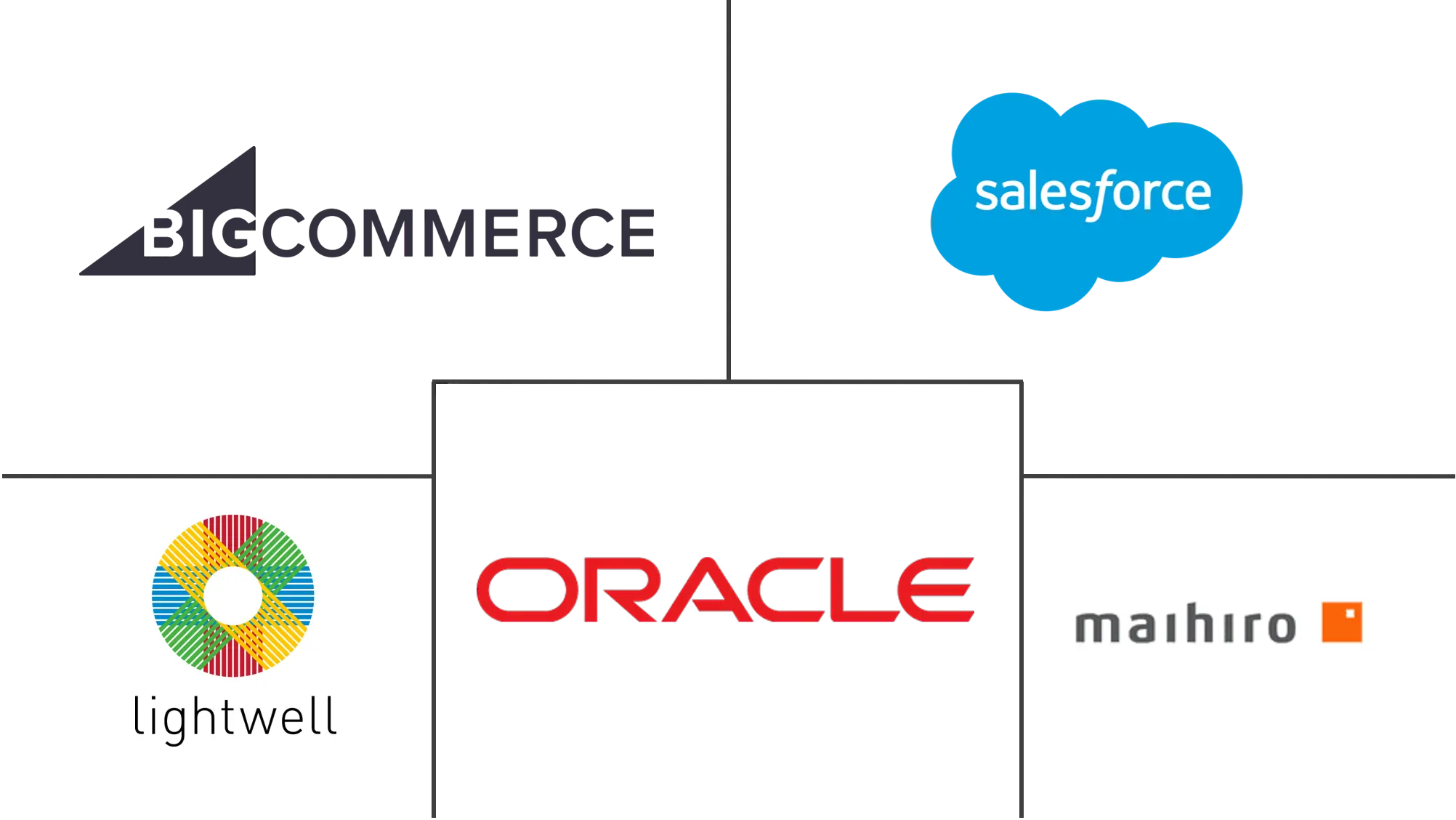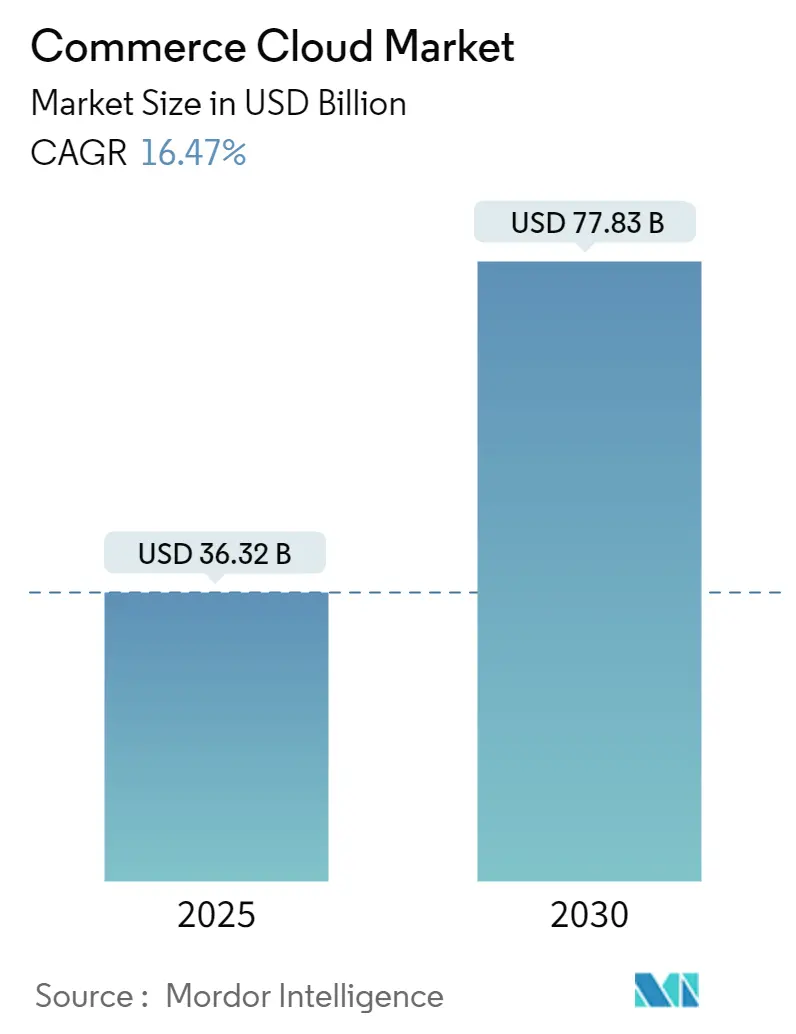
Commerce Cloud Market Analysis
The Commerce Cloud Market size is estimated at USD 36.32 billion in 2025, and is expected to reach USD 77.83 billion by 2030, at a CAGR of 16.47% during the forecast period (2025-2030).
The massive growth of the e-commerce industry, coupled with the significant adoption of cloud computing solutions across industries, is expected to act as a major driver for the growth in the adoption of Commerce Cloud globally.
- Due to its minimal latency and networking virtualization capabilities, 5G is expected to facilitate secure and automated payment methods, which would boost the adoption and usage of cloud applications like mobile payments, smart wallets, and other digital banking services that are anticipated to use 5G for a quick and safer banking experience. Thus, the aforementioned reasons imply that 5G wireless networks would boost the adoption of cloud commerce systems.
- Also, an increasing focus on improving customer experience in the industry is expected to drive the market's growth. Technological advancements are raising customers' expectations and reshaping how they experience different brands. Companies that take a holistic CX (Customer Experience) approach by investing in technologies that will digitally transform the business to stay ahead of customer expectations see a 92% customer retention rate.
- However, privacy and security issues such as data security and network security, among others, are expected to hinder the adoption of Commerce Cloud solutions, especially amongst small and medium-sized businesses.
- Moreover, during the COVID-19 pandemic, the business landscape changed drastically, with a significant increase in the demand for digital business platforms. Hence, Salesforce Commerce Cloud released four quick-start pandemic business packages specifically designed to help conduct business during COVID-19.
- Furthermore, companies require the flexibility of multiple clouds. However, they continue to struggle with the complexity, operational silos, and costs of managing private and public clouds. Businesses require a unified solution that provides a consistent experience, tooling, and operational practices across clouds. Due to this, companies are focusing on enhancing their existing solutions.
- In October 2022, HCL Technologies, a global technology company, and Google Cloud announced the substantial expansion of their long-standing collaboration, with additional capabilities and service solutions to accelerate business migration to Google Cloud.
Commerce Cloud Market Trends
B2C Commerce Platform Expected to Gain Maximum Traction
- Cloud-based technology enables the provision of consistent data, which can drive the growth of these tools. Managing data feeds (data scrubbing, validation, and preparation for distribution) in a cloud-based repository makes it possible to achieve consistent management and distribution of data throughout an organization's internal systems. This ensures that the customers are provided with real-time, updated information that could contribute to a better experience.
- B2C Commerce Cloud Platforms are likely to get the most attention from brands and retailers who are looking for ways to give customers easy and enjoyable shopping experiences. Commerce Cloud has a set of solutions that help brands and retailers come up with new ideas quickly, give customers connected, personalized experiences, and increase customer engagement, sales, and loyalty across channels.
- B2C organizations use digital technology to focus and enhance their retail CRM services across several online channels. Machine learning, artificial intelligence, big data, and other new technologies make it possible for B2C companies to offer customized content on their web, mobile, and social media sites.
- It enables retailers to effortlessly develop and launch new campaigns and promotions based on customer behavior, channel, and location without the need for IT help. AI is used in these systems to make more money by analyzing real-time information about customers and increasing conversions through smart search results.
- Right Scale's annual State of the Cloud Report for 2021 says that 36 percent of companies spend more than USD 12 million per year on public clouds, 59 percent plan to make cloud migration a top priority, and 76 percent use cost efficiency and savings to measure cloud progress.
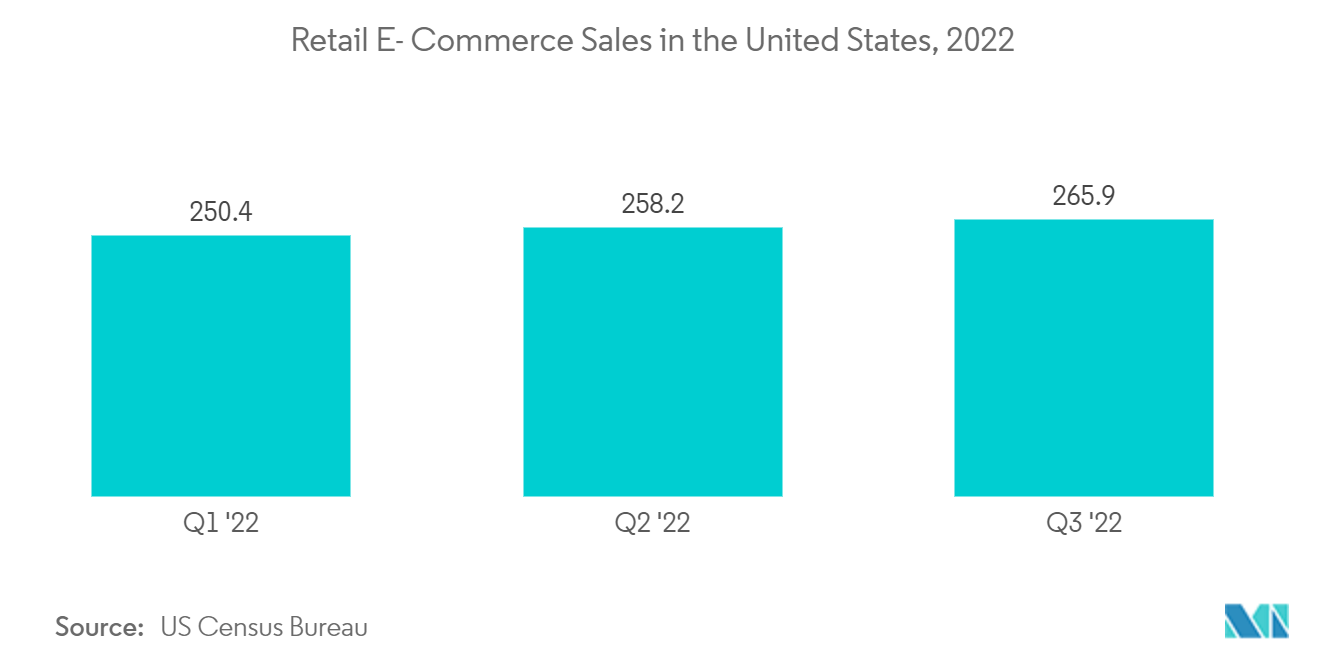
North America Expected to Dominate the Market
- Due to several market players in the region, North America is expected to dominate the commerce cloud market globally, such as IBM, Salesforce, SAP, Oracle, Amazon Web Services, Google LLC, and many more. These regionally based solution providers are making significant investments and innovations in the commerce cloud field to augment regional growth.
- The region's digitization of commerce has resulted in the emergence of new markets, democratizing consumer and seller access to new opportunities. People today have more ways to spend their money than ever before, and businesses have a lot of new digital ways to reach markets they haven't been able to reach before.
- Several retailers collaborate with B2C commerce cloud providers to create unified, intelligent digital commerce experiences, both online and in-store. For instance, in June last year, Salesforce collaborated with TikTok to make it simple for Commerce Cloud merchants to participate in the TikTok community by marketing to consumers and making their products more discoverable. This collaboration is the latest Commerce Cloud platform investment to assist businesses in reaching social-media-savvy customers.
- Salesforce continues to expand its marketing and commerce solutions, focusing on "data-driven experiences." There is a strong emphasis on Marketing Cloud CDP, Salesforce's customer data platform, and it is the launching platform for other advancements. Another point of contention is the connection between Commerce Cloud and Marketing Cloud.
- Companies are also emerging in the region to provide innovative commerce cloud solutions and attract maximum market share. For instance, in June 2022, Salesforce introduced new customer 360 features across its commerce and marketing clouds to help businesses develop trusted connections at scale.
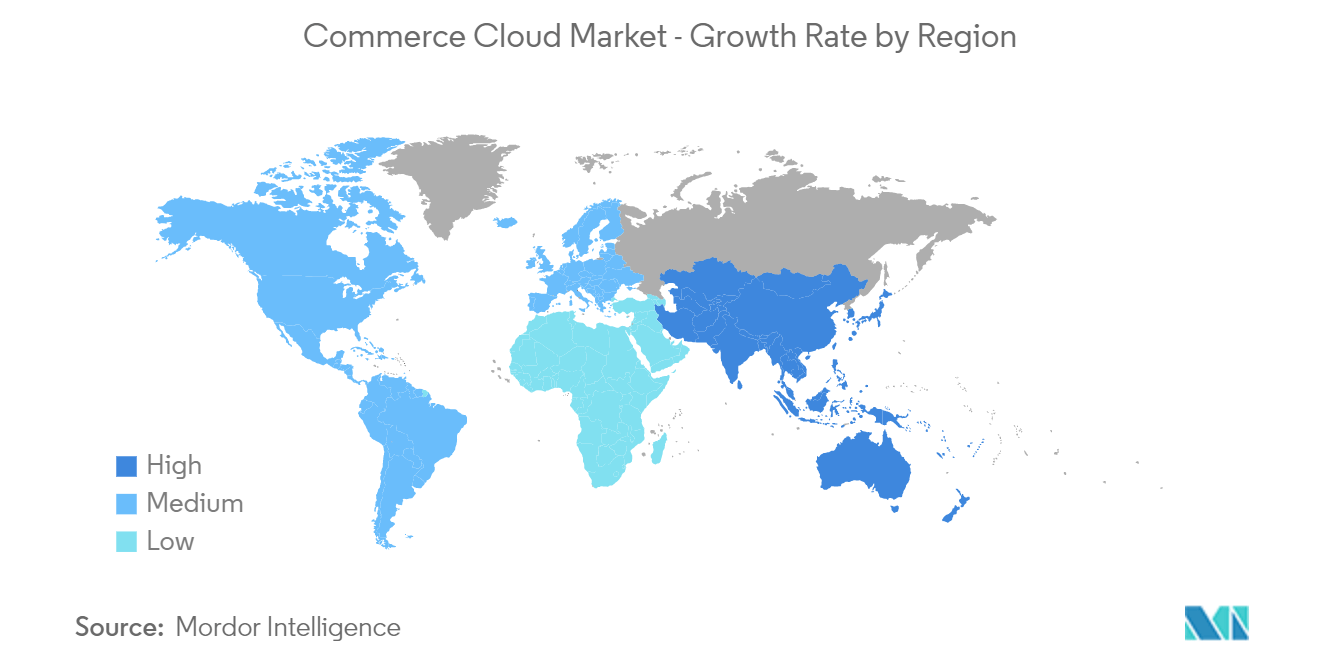
Commerce Cloud Industry Overview
The competitive landscape of the Commerce Cloud market is moderately fragmented owing to the presence of several major players, such as Salesforce, IBM, SAP, Oracle, Amazon Web Services, Google, Adobe, and many others, and the emergence of several small and medium-sized businesses. The market players view expansion as a lucrative path to expand their global presence and attract maximum market share. They are, therefore, making strategic partnerships and collaborations with retailers worldwide. Also, the solution providers are investing significantly to innovate their solutions, which will help them further increase their market presence.
Accenture bought The Stable, a commerce agency that helps consumer brands build and run their own digital commerce channels and manage their brand and sales performance at major North American retailers, in August 2022. This added to Accenture's ongoing investments in commerce, which help clients grow faster and stay relevant.
Commerce Cloud Market Leaders
-
Lightwell Inc. (IBM Corporation)
-
Salesforce.com, Inc.
-
SAP SE (maihiro GmbH)
-
Oracle Corporation
-
BigCommerce Pty. Ltd.
- *Disclaimer: Major Players sorted in no particular order
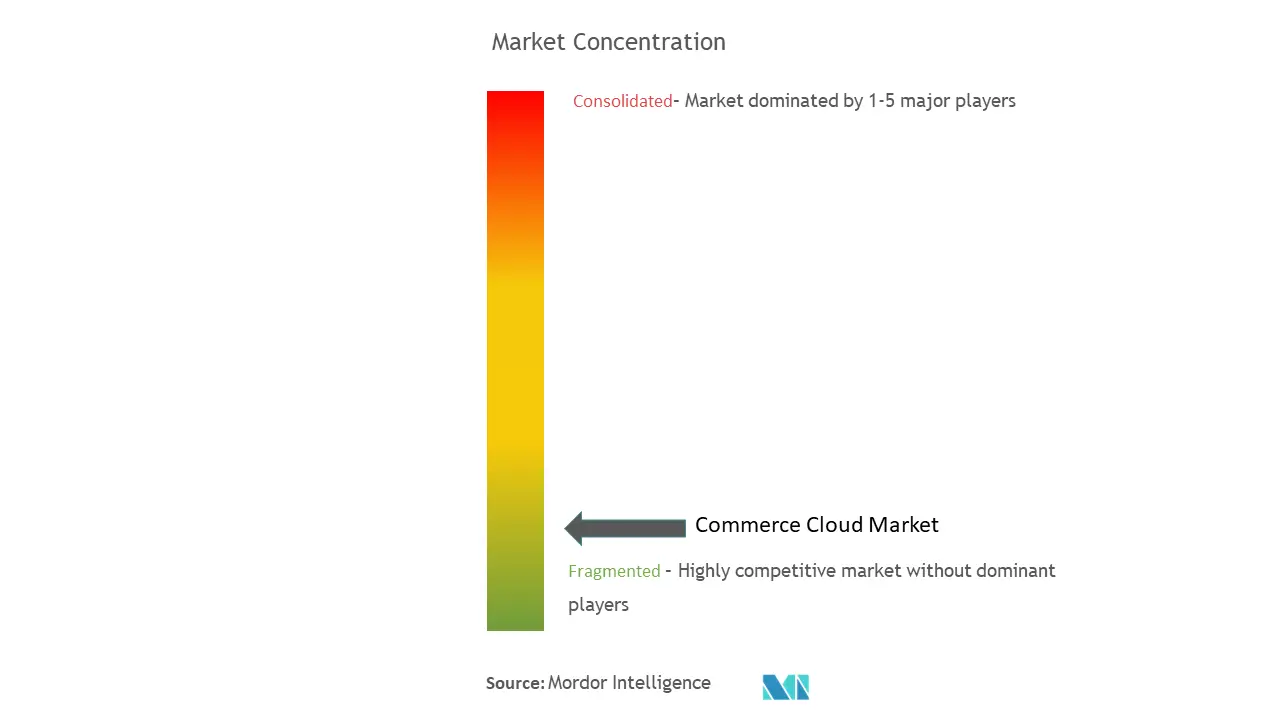
Commerce Cloud Market News
- October 2022: Oracle has introduced new services that will integrate and automate end-to-end business-to-business (B2B) transactions to help enterprises decrease the cost of doing business, improve the customer experience, and provide new offers. By directly linking more than 40,000 buyers, sellers, and service providers through the Oracle Cloud Enterprise Resource Planning, the new Oracle B2B Commerce overcomes the multiple systems, procedures, and data integration difficulties that make B2B transactions so complicated.
- August 2022: Emplifi, an Oracle PartnerNetwork (OPN) customer experience (CX) platform, announced its Social Commerce Cloud now combines with Oracle Commerce and is accessible on the Oracle Cloud Marketplace. Emplifi's new Oracle Commerce connection assists B2B and B2C firms in generating revenue via increasingly popular social media outlets while utilizing an existing eCommerce ecosystem to enhance ROI.
Commerce Cloud Industry Segmentation
Commerce Cloud solutions allow retail businesses to design, deploy, and manage their e-commerce capabilities. It enables customers to derive seamless omnichannel experiences and fulfill their evolving customer expectations. Cloud adoption across industries is influencing retailers to procure and deploy their IT assets due to the cloud's several benefits. Moving to the cloud allows for increased capacity utilization as well as the financial benefits of shifting capital expenditure to operating expenditure, resulting in a lower total cost of ownership.
Commerce Cloud Market is Segmented by End-user Industry (Fashion & Apparel, Pharmaceutical & Grocery, Electronics & Appliances, Travel & Tourism), Platform (B2B Commerce, B2C Commerce), Offering (Private Cloud, Public Cloud, Hybrid Cloud), and Geography (North America, Europe, Asia-Pacific, Latin America, and Middle-East & Africa).
The market sizes and forecasts are provided in terms of value (USD million) for all the above segments.
| By End-user Industry | Fashion & Apparel |
| Pharmaceutical & Grocery | |
| Electronics & Appliances | |
| Food & Beverage | |
| Other End-user Industry (Beauty & Personal Care, Travel & Tourism) | |
| By Platform | B2B Commerce |
| B2C Commerce | |
| By Offering | Private Cloud |
| Public Cloud | |
| Hybrid Cloud | |
| Geography | North America |
| Europe | |
| Asia-Pacific | |
| Latin America | |
| Middle-East & Africa |
Commerce Cloud Market Research FAQs
How big is the Commerce Cloud Market?
The Commerce Cloud Market size is expected to reach USD 36.32 billion in 2025 and grow at a CAGR of 16.47% to reach USD 77.83 billion by 2030.
What is the current Commerce Cloud Market size?
In 2025, the Commerce Cloud Market size is expected to reach USD 36.32 billion.
Who are the key players in Commerce Cloud Market?
Lightwell Inc. (IBM Corporation), Salesforce.com, Inc., SAP SE (maihiro GmbH), Oracle Corporation and BigCommerce Pty. Ltd. are the major companies operating in the Commerce Cloud Market.
Which is the fastest growing region in Commerce Cloud Market?
Asia-Pacific is estimated to grow at the highest CAGR over the forecast period (2025-2030).
Which region has the biggest share in Commerce Cloud Market?
In 2025, the North America accounts for the largest market share in Commerce Cloud Market.
What years does this Commerce Cloud Market cover, and what was the market size in 2024?
In 2024, the Commerce Cloud Market size was estimated at USD 30.34 billion. The report covers the Commerce Cloud Market historical market size for years: 2019, 2020, 2021, 2022, 2023 and 2024. The report also forecasts the Commerce Cloud Market size for years: 2025, 2026, 2027, 2028, 2029 and 2030.
Our Best Selling Reports
Commerce Cloud Industry Report
Statistics for the 2025 Commerce Cloud market share, size and revenue growth rate, created by Mordor Intelligence™ Industry Reports. Commerce Cloud analysis includes a market forecast outlook for 2025 to 2030 and historical overview. Get a sample of this industry analysis as a free report PDF download.

